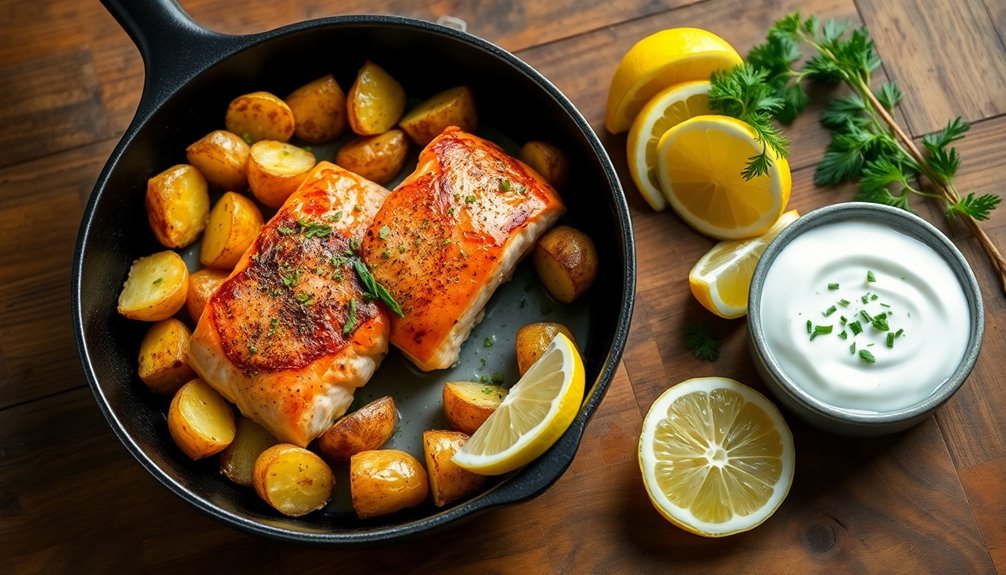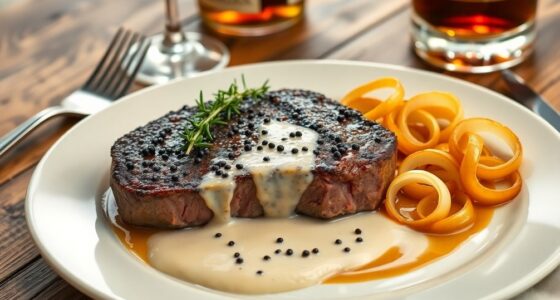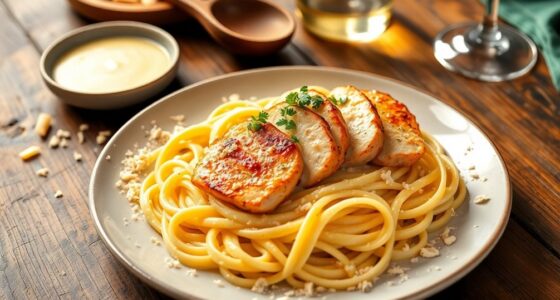Looking for a quick and nutritious dinner? A salmon and potato skillet fits the bill perfectly! You'll combine juicy salmon fillets with hearty baby potatoes, all seasoned with garlic and spices for maximum flavor. It's a simple dish that cooks in about 45 minutes, making it great for weeknights or special occasions. Plus, you can elevate it with a fresh yogurt dip. Ready to discover the cooking steps and tips to make this dish your own?
History
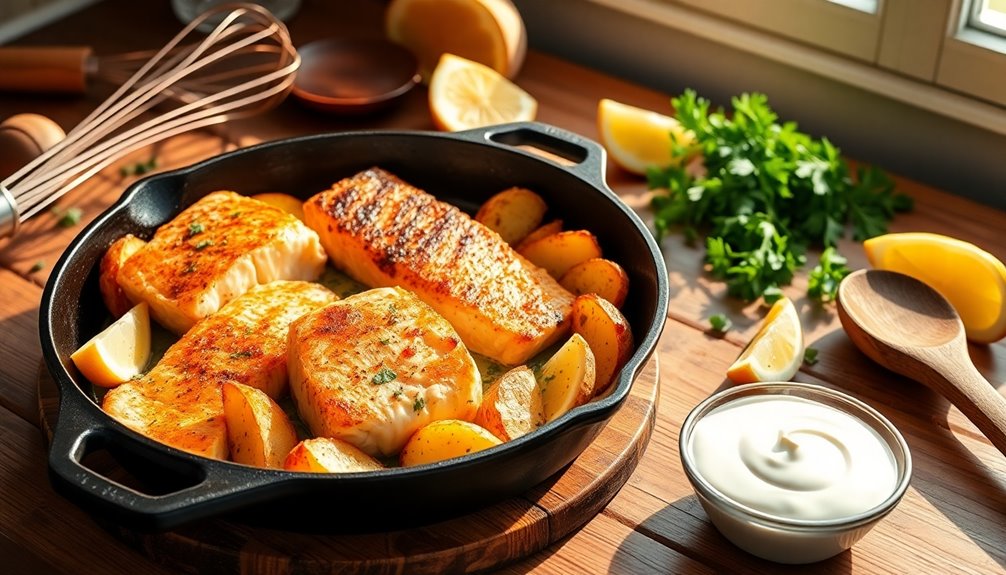
When you explore the history of the salmon and potato skillet, you'll find that this delightful combination has deep roots in coastal cuisines.
Salmon has long been a staple for indigenous peoples in the Pacific Northwest, prepared through various traditional cooking methods like smoking and baking.
Potatoes, introduced to Europe from South America in the late 16th century, quickly gained popularity for their versatility and nutritional value.
The skillet cooking method, evolving from early cast-iron cookware, became a favorite in American Southern cuisine during the 19th century.
Today, this dish shines as a quick and nutritious weeknight dinner, often featuring a creamy sauce that enhances the flavors of both salmon and potatoes, making it a modern classic.
Recipe
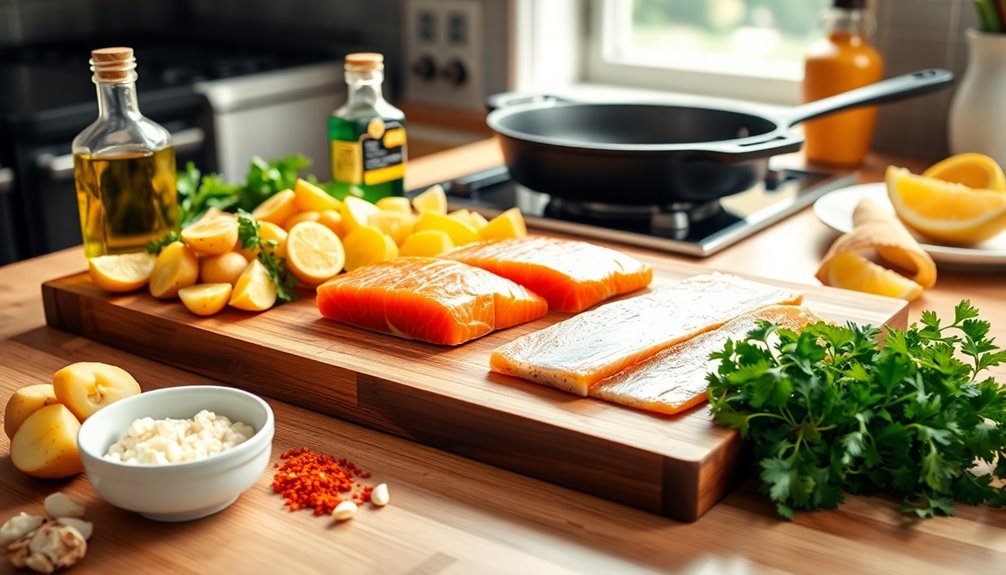
The Salmon & Potato Skillet is a delightful dish that combines the rich flavors of fresh salmon with the heartiness of baby potatoes, all cooked to perfection in a single skillet. This easy-to-follow recipe is perfect for weeknight dinners or a special occasion, and it can be on your table in just 45 minutes. The combination of garlic, red pepper flakes, and spices in the marinade enhances the natural flavors of the salmon and potatoes, making every bite a delicious experience.
To start, you'll want to gather your ingredients and prepare your cooking space. Preheating your cast-iron skillet is essential for achieving that perfect crisp on the potatoes while guaranteeing that the salmon remains moist and tender. Don't forget to prepare the yogurt dip with fresh herbs and lemon wedges, which will brighten up the dish and complement the rich flavors beautifully.
Ingredients:
- 4 skin-on salmon fillets
- 1 pound baby potatoes, halved
- 3 cloves garlic, minced
- 1 teaspoon red pepper flakes
- 1 teaspoon paprika
- 1 teaspoon salt
- 1 teaspoon black pepper
- 2 tablespoons olive oil
- Fresh dill, chopped (for yogurt dip)
- Fresh parsley, chopped (for yogurt dip)
- 1 cup plain yogurt (for yogurt dip)
- Lemon wedges (for serving)
In a large bowl, combine the halved baby potatoes with olive oil, minced garlic, red pepper flakes, paprika, salt, and black pepper, tossing until well coated. Preheat your cast-iron skillet over medium heat and add the seasoned potatoes. Cook the potatoes for about 15-20 minutes, stirring occasionally, until they're golden and tender.
Push the potatoes to one side of the skillet and place the salmon fillets, skin-side down, in the other side. Cook for an additional 10-15 minutes, or until the salmon reaches your desired doneness. While the salmon is cooking, mix the yogurt with dill and parsley in a separate bowl for the dip. Serve the dish hot, garnished with lemon wedges.
For the best results, make sure your salmon fillets are of even thickness to guarantee they cook uniformly. If you're using chicken or pork as a protein substitute, adjust the cooking times accordingly—chicken should reach an internal temperature of 165°F, while pork should be cooked to 145°F. Additionally, using proper insulation can enhance the cooking environment and contribute to even heat distribution.
Leftovers can be stored in an airtight container in the refrigerator for up to three days, making this dish a great option for meal prepping. Enjoy your flavorful and nutritious meal!
Cooking Steps
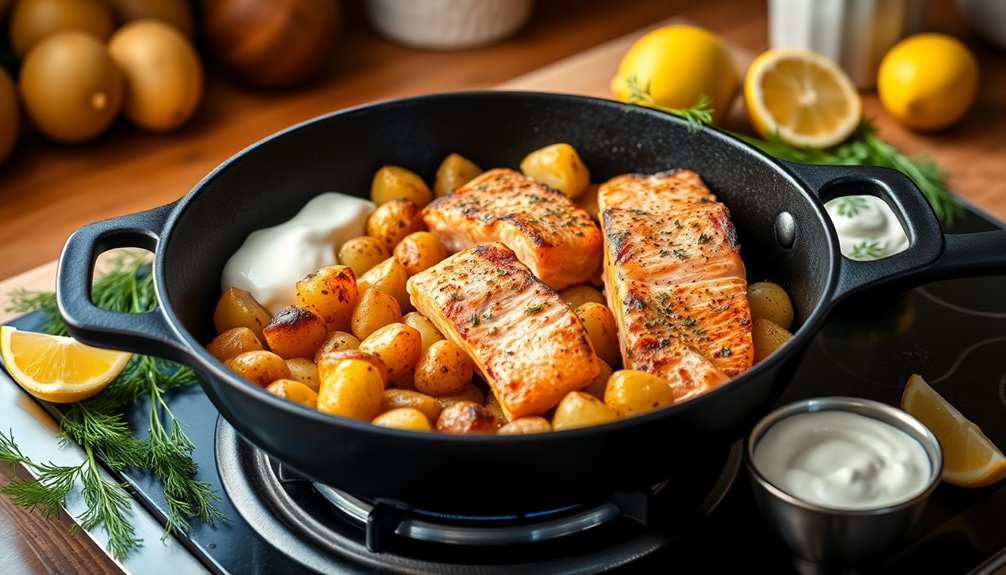
To get started, you'll want to preheat your skillet over medium heat.
Once it's hot, add the diced potatoes and stir in your seasonings for great flavor.
After that, it's time to add the salmon fillets to the skillet and cover to simmer for 10 minutes.
Step 1. Preheat Skillet Over Medium Heat
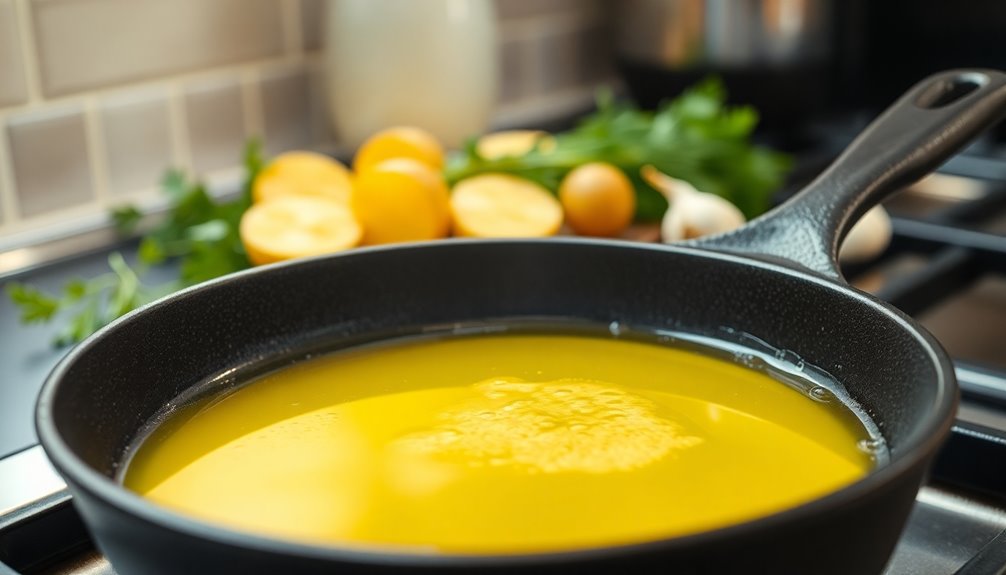
Preheating your skillet is vital for achieving that perfect sear on both the potatoes and salmon. Start by placing your cast iron skillet over medium heat, allowing it to warm up gradually.
If you prefer a quicker method, you can preheat your skillet in the oven at 450°F. This guarantees the skillet reaches a searing hot temperature, essential for locking in moisture and flavor in your salmon fillets.
Once the skillet is hot, add a drizzle of olive oil to create a non-stick surface. This initial roasting time for the potatoes will give you a crispy exterior and a creamy interior. Additionally, diversifying investments can help manage risk, similar to how varying cooking methods can enhance the flavor of your dish.
Just remember to use caution when handling the hot skillet to avoid burns—oven mitts are a must!
Step 2. Add Diced Potatoes to Skillet
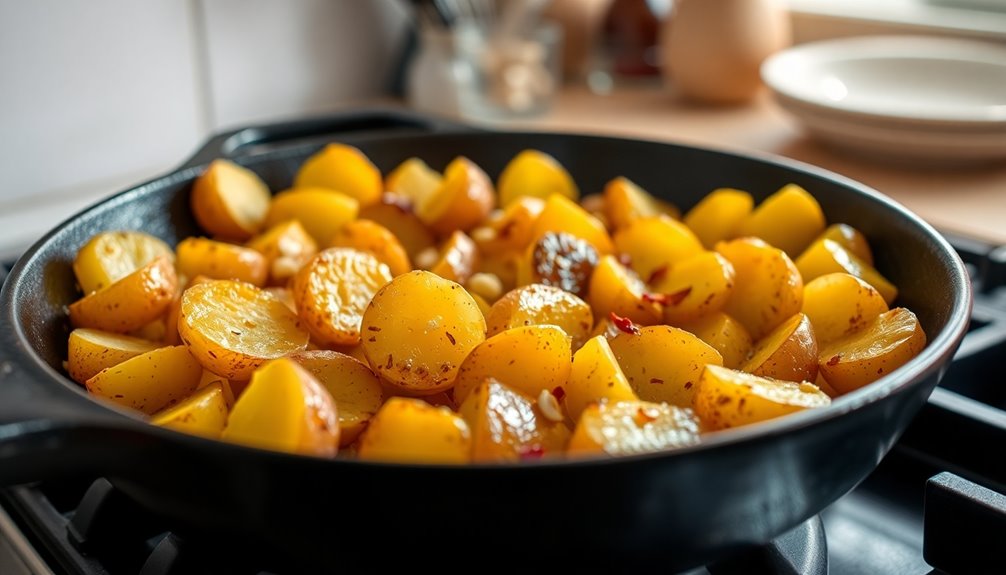
Once your skillet is hot and ready, add the diced potatoes that you've briefly boiled.
Make sure you've boiled them in salted water for about 6 to 8 minutes until just tender, then drain them to prevent overcooking.
Toss the boiled potatoes with a tablespoon of oil, season with salt, and sprinkle on freshly ground pepper for even flavor.
Spread the seasoned potatoes in a single layer in the cast-iron skillet.
Roast them for about 20 minutes, allowing them to develop a crispy exterior. This step is essential for achieving that perfect texture.
After the initial roasting, push the potatoes to one side of the skillet to make room for the salmon and continue with the next steps.
Step 3. Add Seasonings and Stir
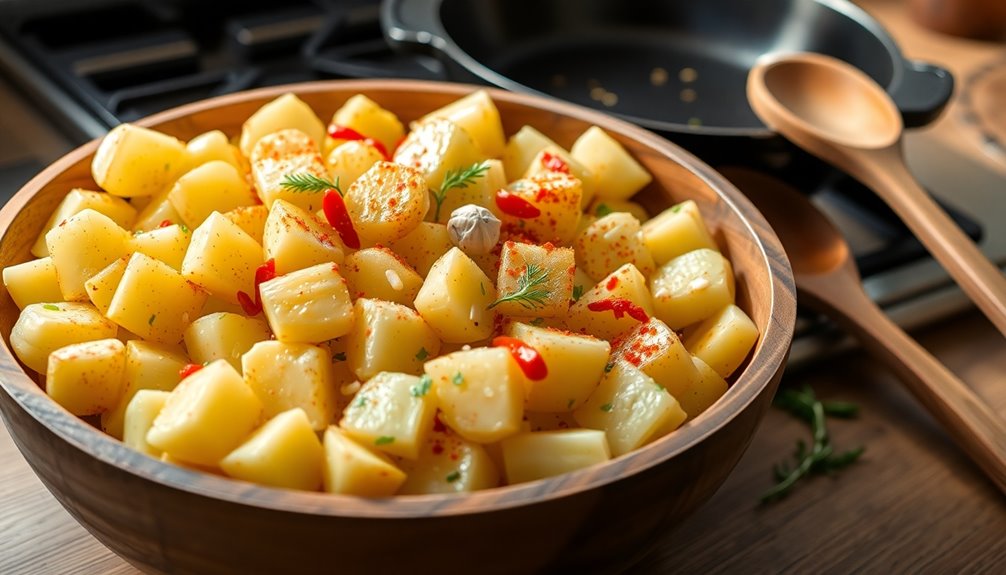
Season the salmon fillets generously with salt, pepper, and a drizzle of olive oil to enhance their flavor.
In a bowl, toss your diced potatoes with a teaspoon of salt, ground black pepper, and more olive oil. This guarantees that each piece is evenly coated in the salmon and potato skillet.
Once the potatoes are tender, introduce additional spices like coriander, cumin, and paprika to create a well-rounded flavor. For a touch of heat, mix in some red pepper flakes.
Stir everything together over medium-high heat, letting the flavors meld together.
The creamy yogurt dip with fresh dill and parsley can be made while the skillet cooks, adding a delicious finishing touch to your meal. Incorporating various add-ins can elevate the dish even further, enriching its overall taste and appeal.
Step 4. Add Salmon Fillets to Skillet
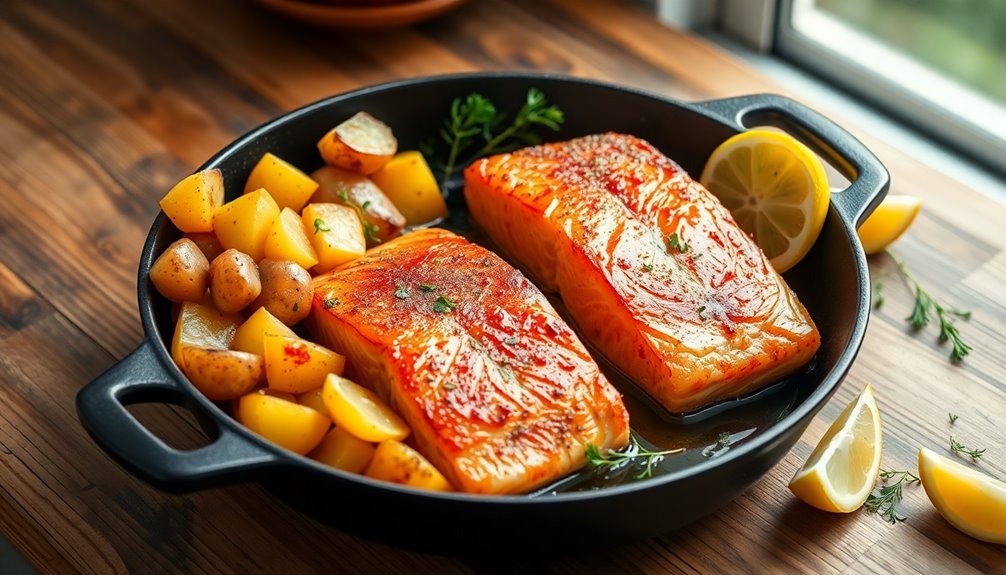
With the potatoes roasted to a tender perfection, it's time to add the salmon fillets to the skillet.
Carefully push the baby potatoes to one side of the hot skillet to create space. Brush the skin side of the salmon fillets with oil and season them with garlic salt and pepper for extra flavor.
Place the salmon skin-side down in the skillet and let it roast for about 5 minutes to achieve that desired crispy skin.
Afterward, flip the salmon fillets over and continue roasting for another 5-10 minutes, or until the fish reaches an internal temperature of 145°F.
Confirm the potatoes remain tender and lightly browned, ready to serve alongside the perfectly cooked salmon.
Step 5. Cover and Simmer for 10 Minutes
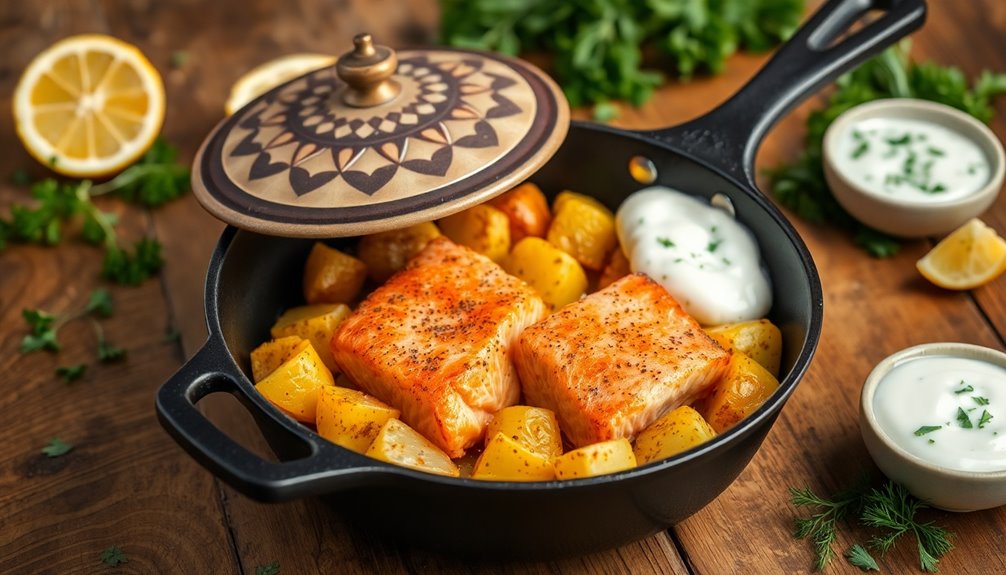
To achieve perfectly cooked salmon and tender shallots, cover the skillet and let it simmer for 10 minutes. This step's vital as it traps steam and moisture, ensuring the salmon is cooked evenly and doesn't dry out.
While the salmon cooks, keep an eye on the potatoes combo; they'll continue to soften during this time. You're aiming for the salmon's internal temperature to reach 145°F (63°C) for safe consumption, which typically happens within the 10-minute simmering period.
The cover maintains a consistent heat environment, important for flaky salmon and flavorful shallots. Once done, season with ground black pepper to enhance the dish's flavor.
Enjoy the delicious results of your careful cooking!
Final Thoughts
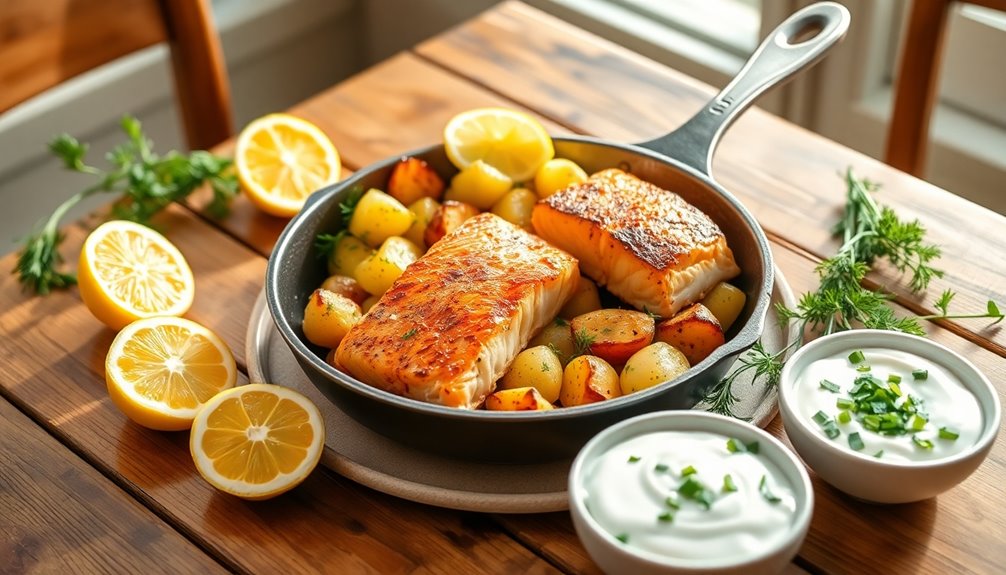
While you might think a delicious meal requires hours of preparation, the Salmon & Potato Skillet proves otherwise. This salmon recipe is quick and easy, taking less than an hour, perfect for your busy weeknights or a cozy date night.
You'll love the combination of creamy salmon and crispy baby potatoes, cooked to perfection in a preheated cast-iron skillet. The flavorful marinade, featuring garlic and red pepper flakes, elevates the taste, making each bite satisfying.
By keeping the potatoes to one side, you guarantee they achieve that perfect crispy texture while the salmon filets remain tender. Don't forget a sprinkle of ground black pepper before serving to enhance the flavors.
Trust me, you'll want to make this recipe again and again!
Frequently Asked Questions
Do Salmon and Potatoes Go Together?
Absolutely, salmon and potatoes go together perfectly! The rich, buttery flavor of salmon balances the earthy taste of potatoes, creating a harmonious dish.
You can season both ingredients in countless ways, allowing for creative expression in your cooking. Plus, they're nutritious—salmon offers high-quality protein and omega-3s, while potatoes provide essential carbohydrates and potassium.
With various cooking methods available, you can easily whip up a delightful meal that highlights their complementary flavors.
Is Salmon Better in the Oven or Skillet?
When deciding whether salmon's better in the oven or skillet, it really depends on what you want.
If you're after a crispy skin and quick cooking, a skillet's your best bet. It lets you sear the fish beautifully.
On the other hand, if you prefer even cooking and less hands-on time, the oven's your friend. Just make sure to monitor the internal temperature to hit that perfect 145°F for ideal flavor and texture.
What Sauce Goes With Salmon and Potatoes?
When you're deciding on a sauce to pair with salmon and potatoes, consider a creamy garlic sauce for richness.
If you want a zesty kick, a lemon-dill sauce will brighten the flavors beautifully.
For a luxurious touch, try a beurre blanc that balances the dish perfectly.
A tangy mustard sauce brings a unique sweet-savory element, while homemade pesto adds a fresh, vibrant taste.
Each option enhances the dish in its own way!
How Does Gordon Ramsay Pan Seared Salmon?
When you're looking to master pan-seared salmon, start with a hot pan and high-quality, skin-on fillets.
Season them with salt and pepper, then lay them skin-side down for that crispy texture you crave.
Use a blend of oil and butter to enhance flavor, cooking for about 4-5 minutes before flipping for another 2-3.
To elevate your dish, add fresh herbs or a splash of lemon juice, creating a delightful experience.
